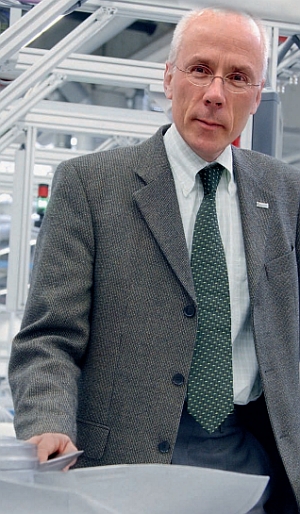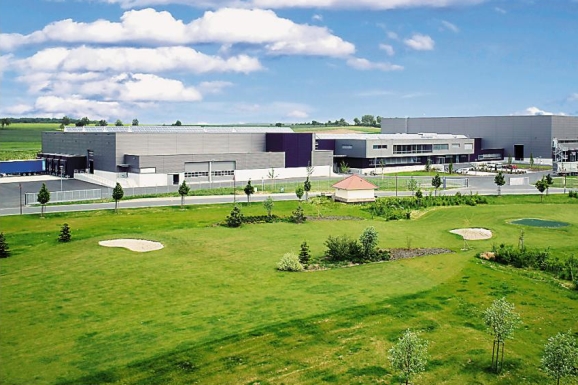Equipped with state-of-the-art technology and spanning over 13,000 square metres, the plant sets benchmarks — including those in energy efficiency. Managing Director Production Thomas Wagner explains the concept behind ebm-papst’s newest location.
Mr Wagner, why is this plant located in Mulfingen-Hollenbach and not in Shanghai, Chennai or another low-wage location?
Thomas Wagner: Because all our data speaks in favour of the Hollenbach location. Refrigeration and air-conditioning technology, the industries for which we manufacture here, is a primarily European business with a high percentage of project business, in which speed and the ability to deliver are important. We cannot supply a customer in Vienna, Offenbach or Sheffield from China. With delivery times from eight to twelve weeks, that takes much too long.
Other than the geographical proximity to the markets, what else speaks in favour of Germany as a location or, more specifically, Hollenbach?
Wagner: For example, when looking at the costs, you have to remember logistics. Ocean freight for one large EC fan is a good 50 dollars! Much more important, however, is the fact that we produce high-tech products that need an appropriate development and production environment. In Hollenbach, we have that: highly skilled, experienced employees, longtime relationships with suppliers, short distances. All those involved in the project are close by and can make their contributions directly. If there is a problem, I can have all of the responsible colleagues sitting at a table in 15 minutes. We can easily produce simple “me-too” articles in cheaper foreign countries, but we manufacture premium products here, in the green Hollenbach countryside. This is supported by rational arguments like those I mentioned, but also, of course, by our close feeling of connection to the region.
The Hollenbach plant is not only located in the green countryside, it also has a lot of green technology built into it. What are you most proud of?
Wagner: The credit belongs primarily to the designers and specialists from a wide variety of trades. In an outstanding display of teamwork, they were able to complete the planning of this plant in just six months and build it in another six.

As Managing Director, Thomas Wagner is in charge of the new plant for large fans in Hollenbach as well as all other worldwide production sites.
Which technologies are most noteworthy with regard to energy efficiency?
Wagner:A number of energy conservation measures have been implemented in the new plant. In addition to a photovoltaic system and the consistent use of components with the highest energy efficiency, the most outstanding feature is the intelligent use of waste heat. We attain a primary energy consumption level that is 80 percent less than the value required by the German Energy Savings Ordinance for new buildings.
How were you able to get the value so low?
Wagner: In industrial buildings, in addition to the energy demand for heating, factors such as the demand for cooling and ventilation are evaluated. Our technology gives us a home advantage in this area. After all, we produce energy-saving EC fans here, and of course we use them in our own ventilation and cooling systems. Thus we are in the green range, both in terms of the efficiency of the plant itself and the products produced here.
What is the “green range” for industrial buildings? Can you give concrete numbers?
Wagner: The primary energy consumption of the entire plant is about 210,000?kWh per year. Normally?—?if we used conventional technology?—?it would be a good million kWh. We keep over 300 tonnes of CO2 per year out of the environment?—?and save 75,000 EUR relative to the annual operating costs for heating, ventilation and cooling. To attain these values, we have implemented a package of measures. The photovoltaic system on the roof supplies up to 153 kilowatts. To support the heating system, we use the temperature stratification in the buildings. This temperature stratification is specifically induced using displacement ventilation. We guide the warm air, which accumulates especially in the higher strata in the production area, through a distribution system and into the cooler areas, such as the warehouse or shipping department. Another noteworthy feature is the sprinkler reservoir, which we use as a heat accumulator.
You use fire extinguishing water as a heat accumulator?
Wagner: Yes, due to the size and design of the hall, we were required to install a sprinkler system with a corresponding water reservoir. Thus the basement of the building has a concrete tank with over one million litres of fire extinguishing water. We use this water as a heat accumulator, for example for the heat given off by the compressor system, which, in turn, serves as the heat source for a heat pump. In summer, the heat pump is used for cooling as a chiller.
ebm-papst has invested about 15 million EUR into this plant. What business goals are being pursued with this investment?
Wagner: Planning for the new building began in Summer 2006. After the split from our sales partner for large fans, we initially added these products to the production in our Mulfingen plant. However, Mulfingen was never designed for these products; problems were caused by the sheer size of the fans with diameters of up to one metre. We were literally running out of space. The new building basically gave us the opportunity to build the plant around the production line, ensuring that production would be optimally suited to these fans. We see an excellent future, particularly for EC fans; the manufacturing plant is currently designed for approximately 800,000 units per year. If it should prove inadequate, we still have enough room to expand. Here, too, everything is going green.
The new Hollenbach plant:
- Ground-breaking: 16 April 2007
- Beginning of move: November 2007/li>
- Employees: approx. 150
- Investments: approx. 15 million EUR
- Production space: 13,500 square metres
- Manufacturing capacity: 800,000 fans
Air-conditioning technology:
- Ventilation: 13 units with EC motors
- Heating and cooling pumps with the highest efficiency class
- Heating with displacement ventilation
- Sprinkler reservoir as heat buffer: 1,100,000 litres
- Photovoltaic system: 153 kW
- Primary energy consumption: 210,000 kWh/a (approx. 1/5 of standard consumption)

Leave a comment